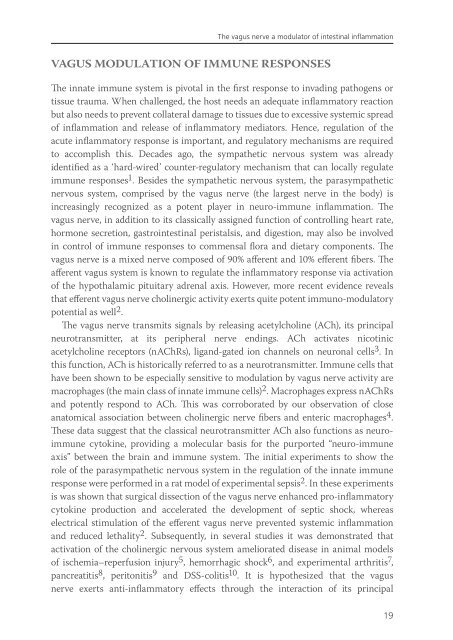The vagus nerve as a modulator of intestinal inflammation - TI Pharma
The vagus nerve as a modulator of intestinal inflammation - TI Pharma
The vagus nerve as a modulator of intestinal inflammation - TI Pharma
You also want an ePaper? Increase the reach of your titles
YUMPU automatically turns print PDFs into web optimized ePapers that Google loves.
<strong>The</strong> <strong>vagus</strong> <strong>nerve</strong> a <strong>modulator</strong> <strong>of</strong> <strong>intestinal</strong> <strong>inflammation</strong><br />
VAGUS MODULA<strong>TI</strong>ON OF IMMUNE RESPONSES<br />
<strong>The</strong> innate immune system is pivotal in the first response to invading pathogens or<br />
tissue trauma. When challenged, the host needs an adequate inflammatory reaction<br />
but also needs to prevent collateral damage to tissues due to excessive systemic spread<br />
<strong>of</strong> <strong>inflammation</strong> and rele<strong>as</strong>e <strong>of</strong> inflammatory mediators. Hence, regulation <strong>of</strong> the<br />
acute inflammatory response is important, and regulatory mechanisms are required<br />
to accomplish this. Decades ago, the sympathetic nervous system w<strong>as</strong> already<br />
identified <strong>as</strong> a ‘hard-wired’ counter-regulatory mechanism that can locally regulate<br />
immune responses 1 . Besides the sympathetic nervous system, the par<strong>as</strong>ympathetic<br />
nervous system, comprised by the <strong>vagus</strong> <strong>nerve</strong> (the largest <strong>nerve</strong> in the body) is<br />
incre<strong>as</strong>ingly recognized <strong>as</strong> a potent player in neuro-immune <strong>inflammation</strong>. <strong>The</strong><br />
<strong>vagus</strong> <strong>nerve</strong>, in addition to its cl<strong>as</strong>sically <strong>as</strong>signed function <strong>of</strong> controlling heart rate,<br />
hormone secretion, g<strong>as</strong>tro<strong>intestinal</strong> peristalsis, and digestion, may also be involved<br />
in control <strong>of</strong> immune responses to commensal flora and dietary components. <strong>The</strong><br />
<strong>vagus</strong> <strong>nerve</strong> is a mixed <strong>nerve</strong> composed <strong>of</strong> 90% afferent and 10% efferent fibers. <strong>The</strong><br />
afferent <strong>vagus</strong> system is known to regulate the inflammatory response via activation<br />
<strong>of</strong> the hypothalamic pituitary adrenal axis. However, more recent evidence reveals<br />
that efferent <strong>vagus</strong> <strong>nerve</strong> cholinergic activity exerts quite potent immuno-<strong>modulator</strong>y<br />
potential <strong>as</strong> well 2 .<br />
<strong>The</strong> <strong>vagus</strong> <strong>nerve</strong> transmits signals by rele<strong>as</strong>ing acetylcholine (ACh), its principal<br />
neurotransmitter, at its peripheral <strong>nerve</strong> endings. ACh activates nicotinic<br />
acetylcholine receptors (nAChRs), ligand-gated ion channels on neuronal cells 3 . In<br />
this function, ACh is historically referred to <strong>as</strong> a neurotransmitter. Immune cells that<br />
have been shown to be especially sensitive to modulation by <strong>vagus</strong> <strong>nerve</strong> activity are<br />
macrophages (the main cl<strong>as</strong>s <strong>of</strong> innate immune cells) 2 . Macrophages express nAChRs<br />
and potently respond to ACh. This w<strong>as</strong> corroborated by our observation <strong>of</strong> close<br />
anatomical <strong>as</strong>sociation between cholinergic <strong>nerve</strong> fibers and enteric macrophages 4 .<br />
<strong>The</strong>se data suggest that the cl<strong>as</strong>sical neurotransmitter ACh also functions <strong>as</strong> neuroimmune<br />
cytokine, providing a molecular b<strong>as</strong>is for the purported “neuro-immune<br />
axis” between the brain and immune system. <strong>The</strong> initial experiments to show the<br />
role <strong>of</strong> the par<strong>as</strong>ympathetic nervous system in the regulation <strong>of</strong> the innate immune<br />
response were performed in a rat model <strong>of</strong> experimental sepsis 2 . In these experiments<br />
is w<strong>as</strong> shown that surgical dissection <strong>of</strong> the <strong>vagus</strong> <strong>nerve</strong> enhanced pro-inflammatory<br />
cytokine production and accelerated the development <strong>of</strong> septic shock, where<strong>as</strong><br />
electrical stimulation <strong>of</strong> the efferent <strong>vagus</strong> <strong>nerve</strong> prevented systemic <strong>inflammation</strong><br />
and reduced lethality 2 . Subsequently, in several studies it w<strong>as</strong> demonstrated that<br />
activation <strong>of</strong> the cholinergic nervous system ameliorated dise<strong>as</strong>e in animal models<br />
<strong>of</strong> ischemia–reperfusion injury 5 , hemorrhagic shock 6 , and experimental arthritis 7 ,<br />
pancreatitis 8 , peritonitis 9 and DSS-colitis 10 . It is hypothesized that the <strong>vagus</strong><br />
<strong>nerve</strong> exerts anti-inflammatory effects through the interaction <strong>of</strong> its principal<br />
19













